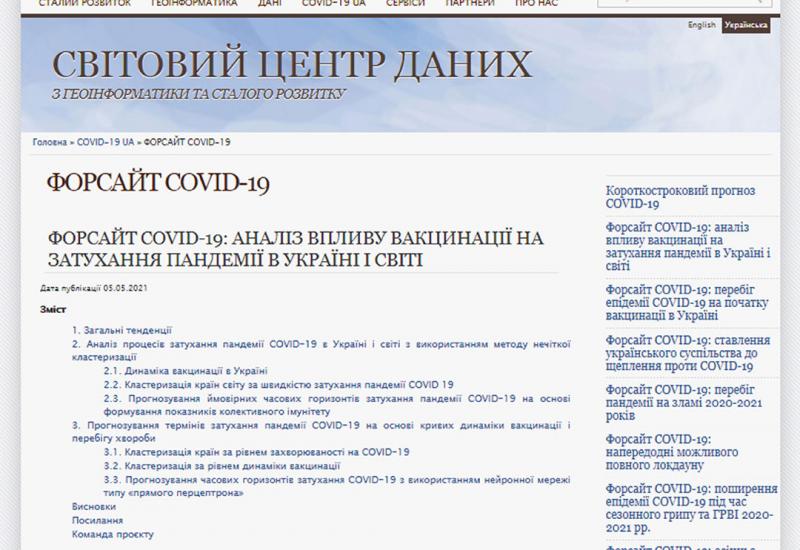Vaccines are proving effective and rapidly scaling, global immunization programs are reaching more and more people, therapies and technologies for treating coronavirus infections are improving. These are just a few key points from the report of McKinsey & Company “When will the COVID-19 pandemic end?” The article analyzes the impact of vaccination on the attenuation of the coronavirus pandemic in different regions and countries around the world.
The articles serve as a basis for a new coronavirus pandemic development scenario, designed by the scientific team of the COVID-19 FORESIGHT. It is the project of the World Data Center for Geoinformatics and Sustainable Development and Lev Gromashevsky Institute of Epidemiology and Infectious Diseases of the NAMS of Ukraine called “FORESIGHT COVID-19: analysis of vaccination rollout on the attenuation of the coronavirus pandemic in Ukraine and throughout the world”. The researchers aimed to analyze the organization and course of vaccination in different countries. Given these trends, they wanted to forecast the approximate time horizons of the attenuation of the COVID-19 pandemic in Ukraine and other countries. Two different mathematical approaches have been used to compare the results and evaluate their reliability.
The study results have been formulated in conclusions. They help make decisions for authorities. Thus, government officials can make adjustments to the tactics of disease prevention and improve the tactics efficiency. The results can also be helpful for ordinary citizens who are not yet considering vaccination. The second case, however, showing the lack of vaccines in Ukraine also influences the situation. The authorities promise to overcome the shortages quickly, although.
Let us consider these conclusions briefly.
According to the vaccination rate and the spread of coronavirus, countries were grouped into five clusters.
The first cluster includes the United States, Israel, the United Kingdom, and the United Arab Emirates. These countries achieved the highest vaccination rates; their average vaccination rate exceeds 60%; it, accordingly, approached herd immunity at the end of the second - beginning of the third quarter of 2021.
The second cluster includes most Western Europe and Canada; herd immunity is more likely at the end of 2021, with a transition toward normalcy in early 2022.
The third cluster is Turkey, some Central European countries, Morocco and Uruguay. In these countries, the vaccination rate does not exceed 20%. The countries ensure strict quarantine standards, yet the daily cases continue to rise. These countries are likely to reach herd immunity closer to mid-2022.
The fourth cluster covers countries with a new wave of cases and slow vaccination. This group includes Ukraine, Russia, Moldova, Georgia, Brazil, Mexico, India, and other countries. The average vaccination rate for this cluster is 4.5%, Ukraine - 1.8%. Given the current vaccination rate, the risks to these timelines are real—herd immunity may not be achieved by the end of 2022 and reach herd immunity only in 2023.
The fifth cluster includes Australia, China, Argentina, and Southeast Asian countries with relatively few cases but at the same time slow vaccination rates. Overcoming the pandemic in these countries may delay the timeline by the end of 2022 and the beginning of 2023.
Therefore, Ukraine is one of the countries with a high risk of prolonged formation of herd immunity. The reasons are the vaccine gap, low vaccination rates (as of May 1, 2021, only 1.8% of the population have vaccinated with one dose, now the situation has improved, but not much), and non-compliance with the quarantine restrictions. Such circumstances regard Ukraine as the country which delays the transition to normalcy and herd immunity. Moreover, our country gains immunity through the most violent method - mainly due to natural infectioning with corresponding high mortality; experiences economic and social stagnation; is isolated from countries that have achieved control of the epidemic situation. Under these conditions, researchers recommend the following steps:
- keep to all anti-epidemic measures with enhanced epidemiological surveillance of COVID-19;
- set vaccination priorities for all previously uninfected persons following the shortest vaccination schedule. The minimum interval between the first and second doses should be four weeks. At the same time, Ukraine currently has a maximum period of 12 weeks which may reduce the expected effectiveness of vaccination,
- if there are enough vaccines, it is necessary to extend vaccination as soon as possible.
And another conclusion is essential for people who have been ill: it is advisable to reconsider approaches to vaccination for them, reducing it to 1 dose on a booster (booster) dose to increase immunity against COVID-19.
More information about the study, its methodology and conclusions can be found here: http://wdc.org.ua/uk/covid19-vaccination-impact-on-attenuation.

